Anatomy of flowering plant 1000+ MCQ with answer for GMAT
Thursday 9th of March 2023

Sharing is caring
1. Which one of the following statement is incorrect ?
A. Only (i)
B. Only (iv)
C. Only (iii)
D. Only (v)
Answer : D
- Epidermal cell has small amount of cytoplasm and a large vacuole.
- Waxy cuticle layer is absent in roots.
- Root hairs are unicellular, while stem hairs / trichomes are multicellular.
- Trichomes may be branched or unbranched, soft or stiff and prevent transpiration.
- Guard cells are dumbell shaped in dicots and beanshaped in monocots (e.g. grass).
A. Only (i)
B. Only (iv)
C. Only (iii)
D. Only (v)
Answer : D
2. The given figure shows the secondary growth in a dicot stem. Their parts are marked as A, B, C, D, E & F. Choose the correct labelling of the parts marked as A to F.

A. A Phellem, B Phellogen, C Medullary rays, D Secondary xylem, E Secondary phloem, F Cambium ring
B. A Phellem, B Phellogen, C Medullary rays, D Secondary phloem, E Secondary xylem, F Cambium ring
C. A Phellogen, B Phellem, C Medullary rays, D Secondary xylem, E Secondary phloem, F Cambium ring
D. A Phellem, B Phellogen, C Cambium ring, D Secondary xylem, E Secondary phloem, F Medullary rays
Answer : A

A. A Phellem, B Phellogen, C Medullary rays, D Secondary xylem, E Secondary phloem, F Cambium ring
B. A Phellem, B Phellogen, C Medullary rays, D Secondary phloem, E Secondary xylem, F Cambium ring
C. A Phellogen, B Phellem, C Medullary rays, D Secondary xylem, E Secondary phloem, F Cambium ring
D. A Phellem, B Phellogen, C Cambium ring, D Secondary xylem, E Secondary phloem, F Medullary rays
Answer : A
3. The given figure shows the T.S of dicot root. Some parts are marked as A, B, C, D, E, & F. Choose the option which shows the correct labelling of marked part.

A. A Epiblema, B Root hair, C Cortex, D Endodermis, E Pith, F Pericycle
B. A Cortex, B Pith, C Epiblema, D Endodermis, E Root hair, F Pericycle
C. A Epiblema, B Endodermis, C Cortex, D Root hair, E Pith, F Pericycle
D. A Cortex, B Epiblema, C Pith, D Endodermis, E Root hair, F Pericycle
Answer : D

A. A Epiblema, B Root hair, C Cortex, D Endodermis, E Pith, F Pericycle
B. A Cortex, B Pith, C Epiblema, D Endodermis, E Root hair, F Pericycle
C. A Epiblema, B Endodermis, C Cortex, D Root hair, E Pith, F Pericycle
D. A Cortex, B Epiblema, C Pith, D Endodermis, E Root hair, F Pericycle
Answer : D
4. Sclerenchyma usually___________and_____________ protoplasts.
A. live, without
B. dead, with
C. live, with
D. dead, without
Answer : D
A. live, without
B. dead, with
C. live, with
D. dead, without
Answer : D
5. As secondary growth proceeds, in a dicot stem, the thickness of
A. sapwood increases.
B. heartwood increase.
C. both sapwood and heartwood increases.
D. both sapwood and heartwood remains the same.
Answer : C
A. sapwood increases.
B. heartwood increase.
C. both sapwood and heartwood increases.
D. both sapwood and heartwood remains the same.
Answer : C
6. Match the names of the structures given in column-I with the functions given in column-II, choose the answer which gives the correct combination of the two columns :
A. A V, B III, C I, D IV
B. A I, B IV, C V, D III
C. A II, B IV, C I, D III
D. A IV, B I, C III, D V
Answer : D
| Column-I | Column-II |
|---|---|
| (Structure) | (Function) |
| A. Stomata | I. Protection of stem |
| B. Bark | II. Plant movement |
| C. Cambium | III. Secondary growth |
| D. Cuticle | IV. Transpiration |
| V. Prevent the loss of water | ... |
A. A V, B III, C I, D IV
B. A I, B IV, C V, D III
C. A II, B IV, C I, D III
D. A IV, B I, C III, D V
Answer : D
7. The trees growing in desert will
A. show alternate rings of xylem and sclerenchyma.
B. have only conjunctive tissue and phloem is formed by the activity of cambium.
C. show distinct annual rings.
D. not show distinct annual rings.
Answer : D
A. show alternate rings of xylem and sclerenchyma.
B. have only conjunctive tissue and phloem is formed by the activity of cambium.
C. show distinct annual rings.
D. not show distinct annual rings.
Answer : D
8. Main function of lenticel is
A. transpiration
B. guttation
C. gaseous exchange
D. both (a) & (c)
Answer : A
A. transpiration
B. guttation
C. gaseous exchange
D. both (a) & (c)
Answer : A
9. Match column-I with column-II and choose the correct option.
A. A III, B V, C IV, D I, E II
B. A II, B V, C I, D III, E IV
C. A II, B IV, C I, D III, E V
D. A III, B I, C V, D II, E IV
Answer : D
| Column -I | Column -II |
|---|---|
| A. Bulliform cells | I. Initiation of lateral roots |
| B. Pericycle | II. Root |
| C. Endarch xylem | III. Grasses |
| D. Exarch xylem | IV. Dicot leaf |
| E. Bundle sheath cells | V. Stem |
A. A III, B V, C IV, D I, E II
B. A II, B V, C I, D III, E IV
C. A II, B IV, C I, D III, E V
D. A III, B I, C V, D II, E IV
Answer : D
10. A piece of wood having no vessels (trachea) must be belonged to
A. teak
B. mango
C. pine
D. palm
Answer : C
A. teak
B. mango
C. pine
D. palm
Answer : C
11. Which one of the following have vessels as their characteristic feature?
A. Angiosperms
B. Gymnosperms
C. Pteridophytes
D. Bryophytes
Answer : A
A. Angiosperms
B. Gymnosperms
C. Pteridophytes
D. Bryophytes
Answer : A
12. In the given columns, column I contain structures of female reproductive system and column II contain its feature. Select the correct match.
A. A - (i), B - (ii), C - (iii), D - (iv)
B. A - (iii), B - (i), C - (ii), D - (iv)
C. A - (i), B - (iv), C - (iii), D - (ii)
D. A - (ii), B - (iv), C - (iii), D - (i)
Answer : A
| Column-I | Column-II |
|---|---|
| A. Lateral meristem | (i) Fascicular vascular cambium, interfascicular cambium and cork cambium. |
| B. Apical meristem | (ii) Produces dermal tissue, ground tissues and vascular tissue. |
| C. Bast fibres | (iii) Generally absent in primary phloem but found in secondary phloem. |
| D. Sap wood | (iv) Involved in the conduction of water and minerals from the root to leaf. |
A. A - (i), B - (ii), C - (iii), D - (iv)
B. A - (iii), B - (i), C - (ii), D - (iv)
C. A - (i), B - (iv), C - (iii), D - (ii)
D. A - (ii), B - (iv), C - (iii), D - (i)
Answer : A
13. Identify A, B and C in the given figure of shoot apical meristem
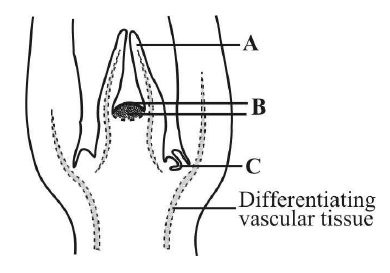
A. A Leaf primordium, B Shoot apical meristem, C Axillary bud
B. A Leaf primordium, B Shoot apical meristem, C Apical bud
C. A Root hair primordium, B Root apical meristem, C Axillary bud
D. A Root hair primordium, B Root apical meristem, C Terminal bud
Answer : A

A. A Leaf primordium, B Shoot apical meristem, C Axillary bud
B. A Leaf primordium, B Shoot apical meristem, C Apical bud
C. A Root hair primordium, B Root apical meristem, C Axillary bud
D. A Root hair primordium, B Root apical meristem, C Terminal bud
Answer : A
14. In stems, the protoxylem lies towards the _____________ and the metaxylem lies towards the ____________ of the organ.
A. centre; periphery
B. periphery; centre
C. periphery; periphery
D. centre; centre
Answer : A
A. centre; periphery
B. periphery; centre
C. periphery; periphery
D. centre; centre
Answer : A
15. T.S. of monocot leaf is given below, certain parts have been marked by alphabets (A G). Which one is the option showing there correct labelling?
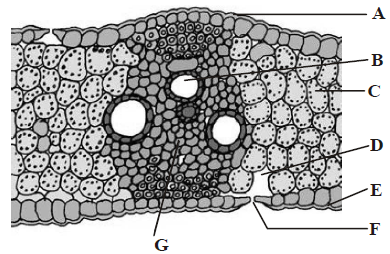
A. A Adaxial epidermis, B Xylem, C Mesophyll, D Sub-stomatal cavity, E Abaxial epidermis, F Stoma, G Phloem
B. A Adaxial epidermis, B Abaxial epidermis, C Xylem, D Sub-stomatal cavity, E Stoma, F Mesophyll, G Phloem
C. A Adaxial epidermis, B Phloem, C Mesophyll, D Sub-stomatal cavity, E Abaxial epidermis, F Xylem, G Stoma
D. A Adaxial epidermis, B Xylem, C Stoma, D Substomatal cavity, E Abaxial epidermis, F Phloem, G Mesophyll
Answer : A

A. A Adaxial epidermis, B Xylem, C Mesophyll, D Sub-stomatal cavity, E Abaxial epidermis, F Stoma, G Phloem
B. A Adaxial epidermis, B Abaxial epidermis, C Xylem, D Sub-stomatal cavity, E Stoma, F Mesophyll, G Phloem
C. A Adaxial epidermis, B Phloem, C Mesophyll, D Sub-stomatal cavity, E Abaxial epidermis, F Xylem, G Stoma
D. A Adaxial epidermis, B Xylem, C Stoma, D Substomatal cavity, E Abaxial epidermis, F Phloem, G Mesophyll
Answer : A
16. Which of the following statements is correct?
A. Lenticels occur in most woody trees.
B. Sclerenchymatous cells are usually present in cortex.
C. The vascular tissue system is divided into three main zones- cortex, pericycle and pith.
D. The conjoint vascular bundles usually have the xylem located only on the outer side of the phloem.
Answer : A
A. Lenticels occur in most woody trees.
B. Sclerenchymatous cells are usually present in cortex.
C. The vascular tissue system is divided into three main zones- cortex, pericycle and pith.
D. The conjoint vascular bundles usually have the xylem located only on the outer side of the phloem.
Answer : A
17. One of the primary function of the ground tissue in a plant is
A. photosynthesis.
B. to protect the plant.
C. to anchor the plant.
D. water and sugar conduction.
Answer : A
A. photosynthesis.
B. to protect the plant.
C. to anchor the plant.
D. water and sugar conduction.
Answer : A
18. Some vascular bundles are described as open because these
A. are surrounded by pericycle but not endodermis.
B. are capable of producing secondary xylem and phloem.
C. possess conjunctive tissue between xylem and phloem.
D. are not surrounded by pericycle.
Answer : B
A. are surrounded by pericycle but not endodermis.
B. are capable of producing secondary xylem and phloem.
C. possess conjunctive tissue between xylem and phloem.
D. are not surrounded by pericycle.
Answer : B
19. Read the following statements and answer the question.
Which plant anatomy is being described by the above statements?
A. Dicotyledonous root
B. Monocotyledonous root
C. Dicotyledonous stem
D. Monocotyledonous stem
Answer : D
- It has a sclerenchymatous hypodermis, a large number of scattered vascular bundles and a large parenchymatous ground tissue.
- Vascular bundles are conjoint and closed.
- Peripheral vascular bundles are generally smaller than the centrally located ones.
- Phloem parenchyma is absent, and water- containing cavities are present within the vascular bundles.
Which plant anatomy is being described by the above statements?
A. Dicotyledonous root
B. Monocotyledonous root
C. Dicotyledonous stem
D. Monocotyledonous stem
Answer : D
20. Identify the types of simple tissue indicated by A, B, C and D and their function.
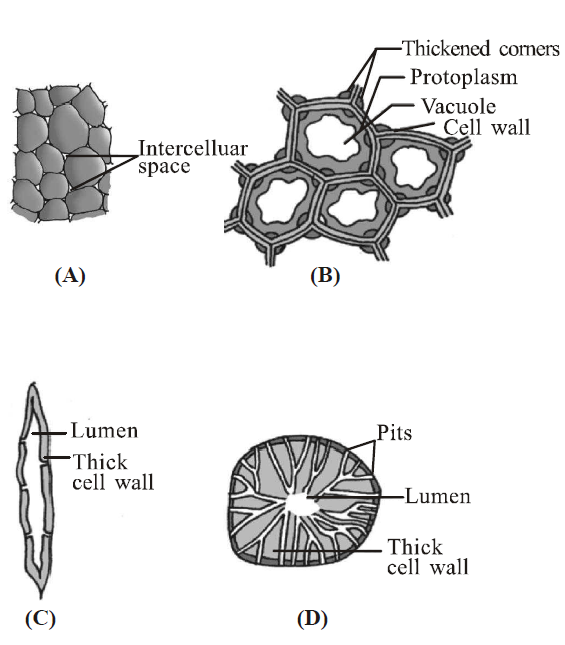
A. A Parenchyma, Photosynthesis, Storage and Secretion.
B. B Sclerenchyma Scleriods; Transport food material
C. C Collenchyma; Provides mechanical support to organs.
D. D Sclerenchyma Fibres; Provide Mechanical support to the growing parts of the plant such as young stem and petiole of a leaf.
Answer : A

A. A Parenchyma, Photosynthesis, Storage and Secretion.
B. B Sclerenchyma Scleriods; Transport food material
C. C Collenchyma; Provides mechanical support to organs.
D. D Sclerenchyma Fibres; Provide Mechanical support to the growing parts of the plant such as young stem and petiole of a leaf.
Answer : A
21. Choose the correct labelling of (A J) in the given figure of T.S. of monocot root.

A. A Root hair, B Epiblema, C Cortex, D Endodermis, E Passage cell, F Pericycle, G Pith, H Phloem, I Metaxylem.
B. A Root hair, B Epiblema, C Cortex, D Endodermis, E Passage cell, F Pith, G Pericycle, H Metaxylem, I Phloem.
C. A Root hair, B Epiblema, C Cortex, D Endodermis, E Pericycle, F Phloem, G Protoxylem, I Metaxylem
D. A Root hair, B Cortex, C Epiblema, D Pericycle, E Endodermis, F Pith, G Phloem, H Protoxylem, I Metaxylem
Answer : C

A. A Root hair, B Epiblema, C Cortex, D Endodermis, E Passage cell, F Pericycle, G Pith, H Phloem, I Metaxylem.
B. A Root hair, B Epiblema, C Cortex, D Endodermis, E Passage cell, F Pith, G Pericycle, H Metaxylem, I Phloem.
C. A Root hair, B Epiblema, C Cortex, D Endodermis, E Pericycle, F Phloem, G Protoxylem, I Metaxylem
D. A Root hair, B Cortex, C Epiblema, D Pericycle, E Endodermis, F Pith, G Phloem, H Protoxylem, I Metaxylem
Answer : C
22. Which meristem helps in increasing girth?
A. Lateral meristem
B. Intercalary meristem
C. Primary meristem
D. Apical meristem
Answer : A
A. Lateral meristem
B. Intercalary meristem
C. Primary meristem
D. Apical meristem
Answer : A
23. Which of the following statements are correct ?
A. (i) and (iii)
B. (i) and (ii)
C. (iii) and (iv)
D. (i) and (iv)
Answer : B
- Xylem transports water and minerals.
- Gymnosperms lack sieve tubes and companion cells in phloem.
- The first formed primary xylem is called metaxylem.
- Phloem fibres (bast fibres) are made up of collenchymatous cells.
A. (i) and (iii)
B. (i) and (ii)
C. (iii) and (iv)
D. (i) and (iv)
Answer : B
24. Bast fibres are made up of _____________cells.
A. sclerenchymatous
B. chlorenchymatous
C. parenchymatous
D. aerenchymatous
Answer : A
A. sclerenchymatous
B. chlorenchymatous
C. parenchymatous
D. aerenchymatous
Answer : A
25. Various functions like photosynthesis, storage, excretion performed by _____________.
A. sclerenchyma
B. parenchyma
C. collenchyma
D. aerenchyma
Answer : B
A. sclerenchyma
B. parenchyma
C. collenchyma
D. aerenchyma
Answer : B
26. Sieve tubes are suited for translocation of food because they possess
A. bordered pits.
B. no ends walls.
C. broader lumen and perforated cross walls.
D. no protoplasm.
Answer : C
A. bordered pits.
B. no ends walls.
C. broader lumen and perforated cross walls.
D. no protoplasm.
Answer : C
27. Cells of permanent tissues are specialized
A. functionally.
B. only structurally.
C. both structurally and functionally.
D. for mitosis.
Answer : C
A. functionally.
B. only structurally.
C. both structurally and functionally.
D. for mitosis.
Answer : C
28. Match column-I with column-II and select the correct option from the codes given below.
A. A IV, B I, C II, D III
B. A III, B II, C I, D IV
C. A I, B II, C III, D IV
D. A IV, B II, C I, D III
Answer : A
| Column-I | Column-II |
|---|---|
| A. Stele | I. Innermost layer of cortex |
| B. Endodermis | II. Suberin |
| C. Casparian strips | III. All the tissues exterior to vascular cambium |
| D. Bark | IV. All the tissues inner to endodermis |
A. A IV, B I, C II, D III
B. A III, B II, C I, D IV
C. A I, B II, C III, D IV
D. A IV, B II, C I, D III
Answer : A
29. In the given figure of phlem tissue, identify the marked part (A, B and C) which help in maintaining the pressure gradient
in the sieve tubes.
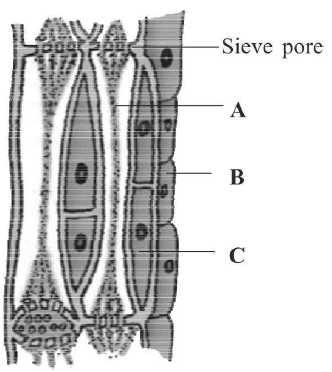
A. A
B. B
C. C
D. None of the above
Answer : C
in the sieve tubes.

A. A
B. B
C. C
D. None of the above
Answer : C
30. Gymnosperms are also called soft wood spermatophytes because they lack
A. cambium
B. phloem fibres
C. thick-walled tracheids
D. xylem fibres
Answer : D
A. cambium
B. phloem fibres
C. thick-walled tracheids
D. xylem fibres
Answer : D
31. A student was given a tissue to observe under the microscope. He observes the tissue and concludes that the tissue is a type of simple plant tissue and provides mechanical support to young stem and petiole of leaf.
Identify the tissue.
A. Parenchyma
B. Collenchyma
C. Sclerenchyma
D. Xylem parenchyma
Answer : B
Identify the tissue.
A. Parenchyma
B. Collenchyma
C. Sclerenchyma
D. Xylem parenchyma
Answer : B
32. Identify types of vascular bundles in given figures A, B and C.
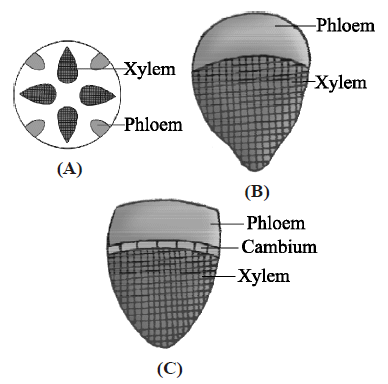
A. Radial; Conjoint closed; Conjoint open
B. Conjoint closed; Conjoint open; Radial
C. Conjoint open; Conjoint closed; Radial
D. Bicollateral; Concentric; Radial
Answer : A

A. Radial; Conjoint closed; Conjoint open
B. Conjoint closed; Conjoint open; Radial
C. Conjoint open; Conjoint closed; Radial
D. Bicollateral; Concentric; Radial
Answer : A
33. Which one of the following option shows the correct labelling of the parts marked as A, B, C and D in the given figure of a typical dicot root?
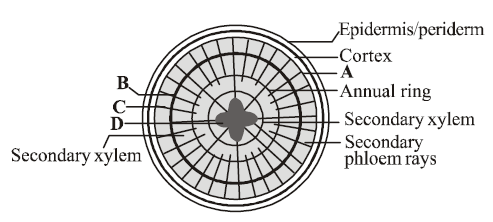
A. A Primary phloem, B Vascular cambium, C Secondary phloem, D Primary xylem
B. A Secondary phloem, B Vascular cambium, C Primary phloem, D Primary xylem
C. A Primary phloem, B Primary xylem, C Secondary phloem, D Vascular cambium
D. A Secondary phloem, B Primary xylem, C Primary phloem, D Vascular cambium
Answer : A

A. A Primary phloem, B Vascular cambium, C Secondary phloem, D Primary xylem
B. A Secondary phloem, B Vascular cambium, C Primary phloem, D Primary xylem
C. A Primary phloem, B Primary xylem, C Secondary phloem, D Vascular cambium
D. A Secondary phloem, B Primary xylem, C Primary phloem, D Vascular cambium
Answer : A
34. Apical, intercalary and lateral meristems are differentiated on the basis of
A. origin
B. function
C. position
D. development
Answer : C
A. origin
B. function
C. position
D. development
Answer : C
35. The __________ occurs in layers below the epidermis in dicotyledonous plants.
A. parenchyma
B. sclerenchyma
C. collenchyma
D. aerenchyma
Answer : C
A. parenchyma
B. sclerenchyma
C. collenchyma
D. aerenchyma
Answer : C
36. Match the terms given in column I with their features given in column II and choose the correct option.
A. A - (i), B - (ii), C - (iii), D - (iv), E - (v)
B. A - (iii), B - (v), C - (ii), D - (iv), E - (i)
C. A - (iii), B - (i), C - (v), D - (ii), E - (iv)
D. A - (v), B - (iv), C - (iii), D - (i), E - (ii)
Answer : B
| Column-I | Column-II |
|---|---|
| (Terms) | (Features) |
| A. Fibres | (i) Cells are living and thin walled with cellulosic cell wall, store food materials in the form of starch or fat |
| B. Sclereids | (ii) Main water conductive cells of the pteridophytes and the gymnosperms |
| C. Tracheids | (iii) Thick walled, elongated and pointed cells, generally occurring in groups |
| D. Vessels | (iv) Long cylindrical tube like structure and cells are devoid of protoplasm. Characteristic feature of angiosperms |
| E. Xylem parenchyma | (v) Reduced form of sclerenchyma cells with highly thickened lignified cellular walls that form small bundles of durable layers of tissue in most plants. |
A. A - (i), B - (ii), C - (iii), D - (iv), E - (v)
B. A - (iii), B - (v), C - (ii), D - (iv), E - (i)
C. A - (iii), B - (i), C - (v), D - (ii), E - (iv)
D. A - (v), B - (iv), C - (iii), D - (i), E - (ii)
Answer : B
37. The vessel elements of angiosperms differ from other elements of xylem in having
A. simple pits on their radial walls.
B. bordered pits on their lateral walls.
C. simple and bordered pits on their end walls.
D. simple perforation on their end walls.
Answer : D
A. simple pits on their radial walls.
B. bordered pits on their lateral walls.
C. simple and bordered pits on their end walls.
D. simple perforation on their end walls.
Answer : D
38. Tissue(s) present in an annual ring is/are
A. secondary xylem and phloem.
B. primary xylem and phloem.
C. secondary xylem only.
D. primary phloem and secondary xylem.
Answer : C
A. secondary xylem and phloem.
B. primary xylem and phloem.
C. secondary xylem only.
D. primary phloem and secondary xylem.
Answer : C
39. The given figure shows T.S. of monocot stem. Identify the correct labelling of A to F marked in the given figure.
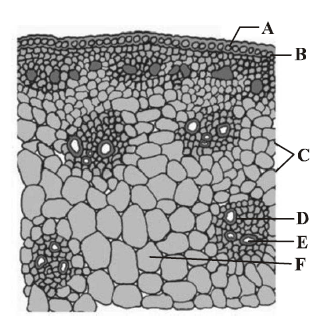
A. A Epidermis, B Hypodermis, C Vascular bundles, D Phloem, E Xylem, F Ground tissue
B. A Cuticle, B Epidermis, C Sclerenchymatous sheath, D Sclerenchymatous hypodermis, E Parenchymatous sheath, F Phloem
C. A Cuticle, B Epidermis, C Sclerenchymatous hypodermis, D Sclerenchymatous sheath, E Parenchymatous sheath, F Phloem
D. A Cuticle, B Epidermis, C Sclerenchymatous hypodermis, D Sclerenchymatous sheath, E Parenchymatous sheath, F Protoxylem
Answer : A

A. A Epidermis, B Hypodermis, C Vascular bundles, D Phloem, E Xylem, F Ground tissue
B. A Cuticle, B Epidermis, C Sclerenchymatous sheath, D Sclerenchymatous hypodermis, E Parenchymatous sheath, F Phloem
C. A Cuticle, B Epidermis, C Sclerenchymatous hypodermis, D Sclerenchymatous sheath, E Parenchymatous sheath, F Phloem
D. A Cuticle, B Epidermis, C Sclerenchymatous hypodermis, D Sclerenchymatous sheath, E Parenchymatous sheath, F Protoxylem
Answer : A
40. Phellogen and phellem respectively denote
A. cork and cork cambium,
B. cork cambium and cork,
C. secondary cortex and cork,
D. cork and secondary cortex,
Answer : B
A. cork and cork cambium,
B. cork cambium and cork,
C. secondary cortex and cork,
D. cork and secondary cortex,
Answer : B
41. The given figure shows apical meristem of root apex with few part marked as A, B and C. Identify the correct labelling of A, B and C.
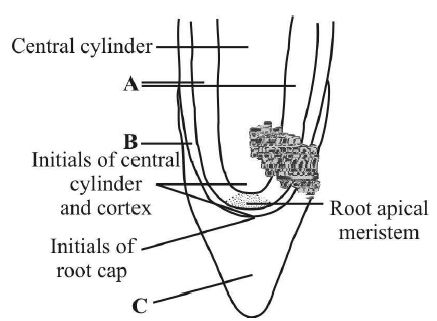
A. A Vascular structure, B Protoderm, C Root cap
B. A Cortex, B Endodermis, C Root cap
C. A Cortex, B Protoderm, C Root cap
D. A Tunica, B Protoderm, C Root cap
Answer : C

A. A Vascular structure, B Protoderm, C Root cap
B. A Cortex, B Endodermis, C Root cap
C. A Cortex, B Protoderm, C Root cap
D. A Tunica, B Protoderm, C Root cap
Answer : C
42. T.S. of dicot stem is given below, certain parts have been marked by alphabets (A I). Choose the option which shows their correct labelling.

A. A Epidermis, B Epidermal hair, C Parenchyma, D Starch sheath, E Hypodermis (collenchyma), F Vascular bundle, G Bundle cap, H Medulla or pith, I Medullary rays
B. A Epidermal hair, B Epidermis, C Hypodermis (collenchyma), D Parenchyma, E Endoderm is (Starch Sheath), F Pericycle, G Vascular bundle, H Medullary rays, I Medulla or pith
C. A Epidermal hair, B Epidermis, C Hypodermis (collenchyma), D Starch sheath, E Parenchyma, F Vascular bundle, G Bundle cap, H Medlla or pith, I Medullary rays
D. A Epidermal hair, B Epidermis, C Parenchyma, D Hypodermis (collenchyma), E Starch sheath, F Vascular bundle, G Bundle cap, H Medulla or pith, I Medullary rays
Answer : B

A. A Epidermis, B Epidermal hair, C Parenchyma, D Starch sheath, E Hypodermis (collenchyma), F Vascular bundle, G Bundle cap, H Medulla or pith, I Medullary rays
B. A Epidermal hair, B Epidermis, C Hypodermis (collenchyma), D Parenchyma, E Endoderm is (Starch Sheath), F Pericycle, G Vascular bundle, H Medullary rays, I Medulla or pith
C. A Epidermal hair, B Epidermis, C Hypodermis (collenchyma), D Starch sheath, E Parenchyma, F Vascular bundle, G Bundle cap, H Medlla or pith, I Medullary rays
D. A Epidermal hair, B Epidermis, C Parenchyma, D Hypodermis (collenchyma), E Starch sheath, F Vascular bundle, G Bundle cap, H Medulla or pith, I Medullary rays
Answer : B
43. A narrow layer of thin walled cells found between phloem/ bark and wood of a dicot is
A. cork cambium
B. vascular cambium
C. endodermis
D. both (a) & (c)
Answer : B
A. cork cambium
B. vascular cambium
C. endodermis
D. both (a) & (c)
Answer : B
44. Match the followings and choose the correct option
A. A III, B IV, C I, D II
B. A I, B II, C III, D IV
C. A III, B II, C IV, D I
D. A III, B II, C I, D IV
Answer : A
| Column-I | Column-II |
|---|---|
| A. Cuticle | I. Guard cells |
| B. Bulliform cells | II. Outer layer |
| C. Stomata | III. Waxy layer |
| D. Epidermis | IV. Empty colourless cell |
A. A III, B IV, C I, D II
B. A I, B II, C III, D IV
C. A III, B II, C IV, D I
D. A III, B II, C I, D IV
Answer : A
45. Cambium is considered as a lateral meristem because
A. it gives rise to lateral branches.
B. it causes increase in girth.
C. it increases height and diameter of a plant.
D. it adds bulk to a plant.
Answer : B
A. it gives rise to lateral branches.
B. it causes increase in girth.
C. it increases height and diameter of a plant.
D. it adds bulk to a plant.
Answer : B
46. Match the terms given in column I with their funciton given in column II and choose the correct option.
A. A I, B III, C V, D II, E IV
B. A III, B I, C II, D V, E IV
C. A II, B IV, C V, D I, E III
D. A V, B IV, C III, D II, E I
Answer : B
| Column-I | Column-II |
|---|---|
| (Term) | (Functions) |
| A. Meristem | I. Photosynthesis, storage |
| B. Parenchyma | II. Mechanical support |
| C. Collenchyma | III. Actively dividing cells |
| D. Sclerenchyma | IV. Stomata |
| E. Epidermal tissue | V. Sclereids |
A. A I, B III, C V, D II, E IV
B. A III, B I, C II, D V, E IV
C. A II, B IV, C V, D I, E III
D. A V, B IV, C III, D II, E I
Answer : B
47. During the formation of leaves and elongation of stem, some cells left behind from the shoot apical meristem, constitute the
A. lateral meristem
B. axillary bud
C. cork cambium
D. fascicular cambium
Answer : B
A. lateral meristem
B. axillary bud
C. cork cambium
D. fascicular cambium
Answer : B
48. Which of the following statement(s) is/are correct ?
A. (i) and (iv) only
B. (ii) and (v) only
C. (iii) and (iv) only
D. (ii), (iii) and (v) only
Answer : D
- Uneven thickening of cell wall is characteristic of sclerenchyma.
- Periblem forms cortex of the stem and the root.
- Tracheids are the chief water transporting elements in gymnosperms.
- Companion cell is devoid of nucleus at maturity.
- The commercial cork is obtained from Quercus suber.
A. (i) and (iv) only
B. (ii) and (v) only
C. (iii) and (iv) only
D. (ii), (iii) and (v) only
Answer : D
49. The given figures are types of elements (A and B) which constitute one type of complex tissue (c) of a plant . Identify A, B and C.
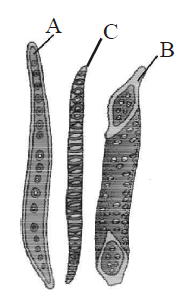
A. A Tracheid, B Vessel, C Xylem
B. A Vessel, B Tracheild, C Phloem
C. A Fibre, B Tracheid, C Bark
D. A Fibre, B Sclereid, C Casparian strips
Answer : A

A. A Tracheid, B Vessel, C Xylem
B. A Vessel, B Tracheild, C Phloem
C. A Fibre, B Tracheid, C Bark
D. A Fibre, B Sclereid, C Casparian strips
Answer : A
50. Which of the following statement(s) is/are not correct?
A. (iii) and (iv)
B. (i) and (ii)
C. (ii) and (iii)
D. (ii) and (iv)
Answer : A
- Cork cambium is also called phellogen.
- Cork is also called phellem.
- Secondary cortex is also called periderm.
- Cork cambium, cork and secondary cortex are collectively called phelloderm.
A. (iii) and (iv)
B. (i) and (ii)
C. (ii) and (iii)
D. (ii) and (iv)
Answer : A
Sharing is caring
Related Post
Automobile Engineering MCQ Solved Paper for IBPS RRB
1000+ Auto CAD 2D MCQ for UPSC CDS [Solved]
General Physics MCQ Solved Paper for UPSC CSE
Manufacturing & Production Engineering 1000+ MCQ with answer for CTET
Antonyms MCQ Solved Paper for SSC MTS
Current Affairs April 2017 1000+ MCQ with answer for LIC ADO